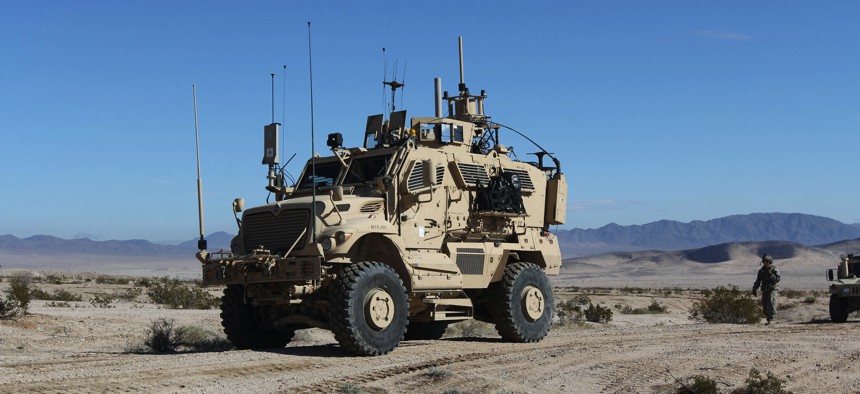
An electronic warfare tactical vehicle supports a training rotation for the Army’s 3rd Brigade Combat Team, 1st Cavalry Division, at the National Training Center at Fort Irwin, Calif., Jan. 13, 2019. Steven Stover, Army
Old-Time Radio: Pentagon’s Electronic-Warfare Gear Is Dated, Experts Say
Lawmakers say more of the EW budget should go to R&D.
The U.S. military is spending too little on new electronic warfare gear, putting it behind China and Russia in the race to jam radios, spoof radars, and hide their own emissions, experts and lawmakers said Tuesday.
A decade of past development is bringing new tools online, but too little of the approximately $10 billion per year allocated for electromagnetic warfare is being spent on what comes next, while too much is being spent to maintain even older gear, said Bryan Clark, a senior fellow and director of the Center for Defense Concepts and Technology at the Hudson Institute.
Speaking online during a Hudson Institute event, Clark said the U.S. military “needs to move away from” having “a small number of relatively large systems that are mostly devoted to protecting legacy platforms, so systems for the protection of aircraft that have self-protection jammers or...ships that have counter missile systems that use electromagnetic warfare.”
Timothy Walton, a Hudson colleague of Clark’s and co-author of a new report on EW, said that Chinese electromagnetic warfare tactics have evolved in recent years.
The Chinese “have a range of low- and high-powered jammers and directed-energy weapons, but one of the greatest challenges that Chinese forces are now facing for the United States and its allies is that the[ People's Liberation Army] has started to network large numbers of signals, both passive and active sensors, in multistatic and completely passive networks.”
These new networks are better able to detect attacking forces even if those forces aren’t emitting signals, he said. “It makes it very challenging for U.S. forces for instance to know when they're being detected and possibly when they're being targeted.”
Rep. Jim Langevin, D-R.I., said that recent Pentagon budgets haven’t put money toward the right mix of EW gear. “I don't think they're prioritizing the right things in the budget,” said Langevin, chair of the House Armed Services Committee Subcommittee on Cyber, Innovative Technologies, and Information Systems.
Traditional electromagnetic warfare tools and tactics rely a lot on complex pieces of hardware to manipulate different wavelengths in the electromagnetic spectrum. But more modern approaches emphasize the use of software to find, intercept, and transmit in different wavelengths with fewer pieces of hardware.
“The requirements right now are really hardware-driven, with software treated as a back office support system and that really needs to change,” Langevin said. “One of the problems is that, you know, the services and their budgets revolve around protecting legacy systems like ships and airplanes, and, you know, the bottom line is we need to be more nimble. We need to innovate. We need to focus more on software as a technology.”





